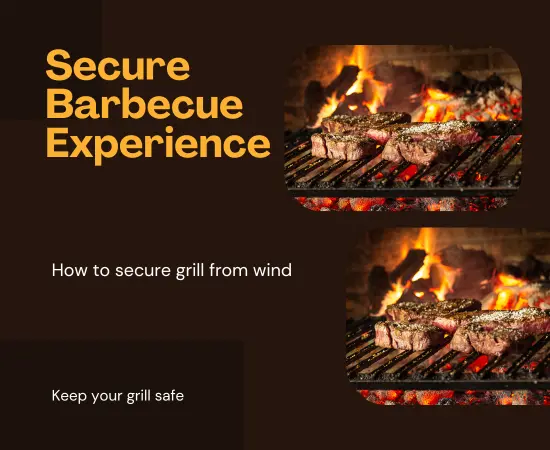This post may contain affiliate links. If you use these links to buy something we may earn a small commission. Thanks.
Introduction: Grilling is a favorite pastime for many, offering the opportunity to enjoy delicious meals in the great outdoors. However, windy conditions can pose challenges and even potential hazards when it comes to grilling. To ensure a safe and enjoyable cooking experience, it is important to take necessary precautions to secure your grill from wind. In this article, we will explore a range of effective methods and strategies to protect your grill from wind, allowing you to grill with confidence.
Choosing the Right Location
Selecting an appropriate location for your grill is crucial when it comes to wind protection. Consider the following factors:
Sheltered Area: Look for a spot that offers some natural protection from the wind, such as a corner of your patio, close to a wall, or under a pergola. These structures can act as barriers, minimizing the direct impact of wind on your grill.
Wind Patterns: Observe the wind patterns in your outdoor space. Note the direction from which the wind typically blows and position your grill in a way that minimizes exposure to strong gusts.
Avoid Open Spaces: Avoid placing your grill in wide-open areas where wind can gather momentum. Instead, opt for locations with surrounding structures that can create a windbreak.
Windbreaks
Creating windbreaks around your grill is an effective strategy to minimize the impact of wind. Here are some options to consider:
Privacy Screens: Use freestanding privacy screens or trellises to create a barrier against the wind. These screens can be positioned strategically around your grill, shielding it from direct gusts.
Temporary Walls: If you have a permanent grill setup or a designated grilling area, consider building temporary walls using materials such as plywood or cinder blocks. Ensure these walls are securely anchored to withstand wind pressure.
Natural Barriers: Utilize the natural elements in your outdoor space, such as hedges, bushes, or trees, to create a natural windbreak. These features not only offer protection but also enhance the ambiance of your grilling area.

Grill Placement and Orientation
The way you position your grill can significantly impact its resistance to wind. Consider the following suggestions:
Back Against the Wind: Orient your grill so that its back faces the direction of the prevailing wind. This helps create a buffer zone, reducing the direct impact of gusts on the grill’s cooking surface.
Side Shields: If the wind tends to come from specific angles, consider placing portable shields or barriers on the sides of your grill to deflect the wind away from the cooking area.
Adjust Grill Height: Some grills offer adjustable cooking surfaces. In windy conditions, lower the grill surface closer to the heat source to reduce the impact of gusts.
Secure Your Grill
Properly securing your grill is essential to ensure stability and prevent accidents. Consider the following measures:
Use Weighted Anchors: If you have a portable grill, invest in weighted anchors designed specifically for grills. These anchors provide stability by securing the legs or wheels of the grill to the ground.
Grill Carts or Stands: If you own a larger grill, consider investing in a sturdy grill cart or stand with locking wheels. This will provide additional stability and make it easier to move the grill in and out of windy areas.
Bracing and Tie-Downs: In extreme wind conditions, use braces or tie-downs to secure your grill to nearby structures or stationary objects. Ensure that the connections are strong and reliable.
Cover Your Grill
Investing in a high-quality grill cover is not only beneficial for protection against the elements but also helps secure your grill from wind. Here’s why:
Wind Resistance: A fitted grill cover can act as a wind-resistant shield, reducing the direct impact of gusts on the grill’s exterior.
Prevent Dust and Debris: Wind often carries dust, dirt, and debris that can accumulate on your grill. A cover protects the grill’s surfaces, preventing debris from affecting its performance.
Waterproofing: Opt for a cover made of waterproof material to shield your grill from rain or moisture that can damage its components.
How To Put Out A Charcoal Grill Without A Lid
How Do You Secure an Outdoor Grill?
Securing an outdoor grill is essential to ensure its stability, prevent accidents, and protect it from various elements. Here are some effective methods to secure an outdoor grill:
- Level Ground: Ensure that the ground where you place your grill is level. Uneven surfaces can compromise the stability of the grill, especially in windy conditions. If needed, use a shovel or a level to make adjustments to the ground.
- Stable Base or Foundation: If your grill doesn’t come with a built-in stand or cart, consider placing it on a stable base or foundation. This can be a concrete slab, patio stones, or a sturdy grill platform. The base should be strong enough to support the weight of the grill and provide stability.
- Weighted Anchors: For portable grills, invest in weighted anchors designed specifically for grills. These anchors typically attach to the legs or wheels of the grill and help secure it to the ground. They add stability and prevent the grill from tipping over in windy conditions.
- Secure Wheels: If your grill has wheels, make sure they are locked in place. Locking the wheels prevents the grill from moving or rolling away due to wind or accidental nudges.
- Bracing and Tie-Downs: In extremely windy areas or during severe weather conditions, consider using additional bracing or tie-downs to secure the grill to nearby structures or stationary objects. This can be done using straps, bungee cords, or heavy-duty ropes. Ensure that the connections are strong and reliable.
- Sheltered Location: Position your grill in a sheltered area to reduce its exposure to strong winds. This can be against a wall, under a pergola, or in a corner of your patio. By placing the grill in a location that offers natural protection, you can minimize the direct impact of wind and improve its stability.
- Windbreaks: Create barriers or windbreaks around your grill to shield it from gusts. This can be achieved using freestanding privacy screens, trellises, temporary walls, or even natural elements like hedges or trees. These windbreaks help redirect the flow of wind, reducing its impact on the grill.
- Use a Grill Cover: When the grill is not in use, cover it with a high-quality grill cover. A cover protects the grill from various elements, including wind, rain, dust, and debris. Ensure that the cover fits properly and is made of weather-resistant material.
Remember, securing your grill is not only about protecting it from wind but also about maintaining safety. Always follow the manufacturer’s guidelines and recommendations for your specific grill model. Regularly inspect and maintain the grill, checking for any loose parts or signs of wear and tear. By taking these precautions, you can enjoy a secure and worry-free grilling experience.
Conclusion
Securing your grill from wind is crucial to ensure a safe and enjoyable grilling experience. By carefully selecting the location, creating windbreaks, positioning the grill appropriately, and implementing secure measures, you can mitigate the risks associated with windy conditions. Remember to invest in a quality grill cover to protect your grill from both wind and other elements. By following these tips, you’ll be able to enjoy delicious grilled meals while minimizing the impact of wind on your cooking experience. Happy grilling!
